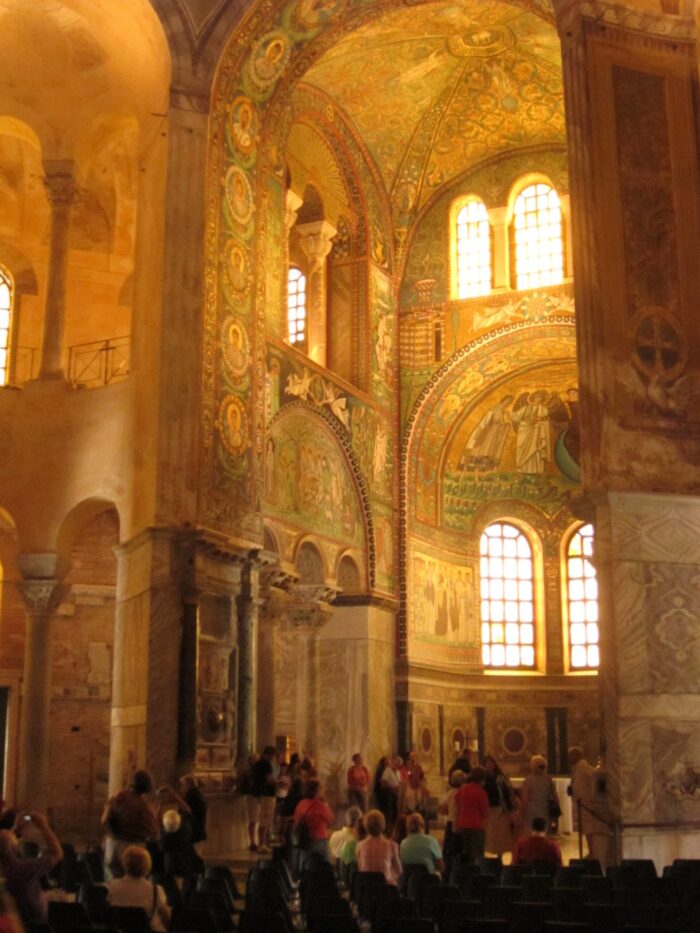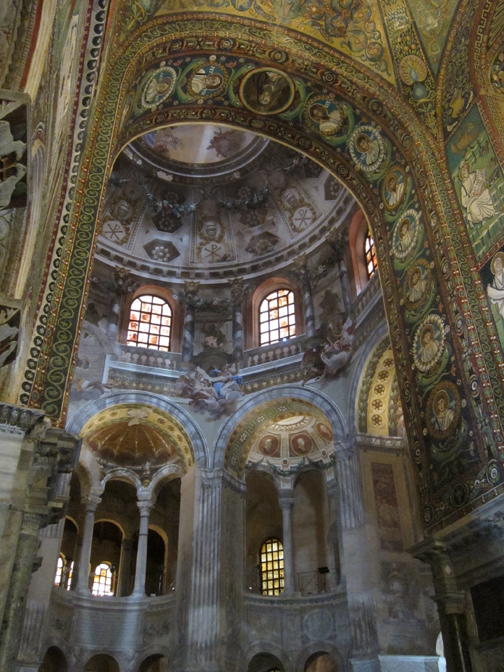Available for Purchase.
"*" indicates required fields
This submission is an inquiry of availability and details but does not guarantee a sale. Thank you for your understanding.

The Presbytery and Apse of San Vitale
(Author’s photo.)
Note: A recent post on Instagram of photos from Ravenna gave me a moment of unexpected pleasure remembering my own trip there more than a decade ago. The following is an edited (and amended) version of a longer entry I originally authored on my earlier blog, Venetian Red.

When I sat in a darkened college lecture hall many decades ago viewing slides of the various mosaics in Ravenna’s early churches, never did I ever imagine that one day I would be standing in those spaces, utterly awestruck by the magnitude of the artistic achievement they represented.

Consecrated in 547, San Vitale is considered to be among the premier surviving examples of the “Eastern Roman” (Byzantine) architectural style. As I entered the grand vaulted space of this octagonal structure and the comprehensive mosaic program came into view, I could swear my body was vibrating with excitement. Literally every square centimeter of the basilica walls was covered with brilliantly colored tiles, all in the service of the narrative program—Old & New Testament stories, abstract paradisiacal designs, depictions of Christ and the Apostles, as well as portraits of Emperor Justinian, Empress Theodora and the Bishops, all of whom made the building possible.

Individual tesserae—in shades of turquoise, green, red, brown, black, white, and of course gold, lots of gold—create a riot of gorgeous chromatic harmony. Afternoon light streaming through amplely-sized windows bounces off all those tiny pieces of glass, bathing the space in a suffused rich glow. On the one hand, San Vitale is full-throttle terrestrial shock and awe. On the other, It’s hard not to feel spiritual reverence in this space.

In the mid 6th century, the Roman Empire was embroiled in the Gothic War, as the Byzantine Empire (Eastern Roman Empire) struggled to oust the Ostrogothic Kingdom from Roman lands. In 540, the Byzantine general Belisarius reconquered Ravenna, a critical step in Emperor Justinian’s (527-565) campaign to reclaim Italy. Though the war continued, Ravenna Bishops must have been thankful that their city at least had gained back friendly protectors.


By all accounts Justinian was a remarkable ruler, read more.

Capitals with peacocks and other paradaisical motifs
San Vitale, Ravenna (Author’s photo.)
Rome ultimately fell to the German chieftain Odoacer in 476, but the Roman Empire continued for 1,000 years under Byzantine Emperors, who ruled the vast territory from their seat in Constantinople (Istanbul). While Eastern Emperors never gave up the idea of reconquering Rome, as the centuries wore on, their Empire declined in political influence and became more isolated from Europe.


Floor Mosaics, San Vitale
(Author’s photos.)
The mosaic program at San Vitale was meant to convey a single idea—the redemption of mankind by Christ. But the mosaics of San Vitale served many purposes—they were a reminder to the 6th century world of the meaning of the Eucharistic rite, of the glory in the recently-sanctioned Christian religion, and of the idea that beauty is created by man in service of the divine. If a congregant’s attention were to wander during a service, better the eyes should come to rest on instructive scenes rendered in exquisite beauty. In our modern world, it’s hard not to think that this glittering prize of a basilica also paid homage to the glory of the Roman Empire and the promise of its rejuvenation under Justinian.
Today, regardless of whether they are viewed within a religious or secular context, to me these walls are among the most beautiful in Italy.

Beyond the Brief

This post offers a rich mix of art and history and how they intersect. And such outstanding examples of mosaic art! To enter such a space must be to feel oneself in that other World.
I spent one full day in Ravenna and found it nearly impossible to absorb the mosaics in that short time. I do remember the Mausoleum of Galla Placidia as a highlight, however, and have some faint feeling-state residue of that visit.
And I do remember the food in Ravenna as being superb!
While I am probably more familiar with Byzantine art around the time of Justinian, particularly portraits of he and his wife (whose name I can’t recall), these images in Ravenna are breathtaking. I haven’t been there and if I am lucky enough to again visit Italy, I would like to see this.
The churches of Italy fascinated me more than most. The excesses put into the design, the gold, gold leaf, precious stones and costly minerals juxtaposed with the poverty of the people living nearby, e.g. Vatican City and the poor who hang outside of it, is hard to understand. I’ve always thought religions use glorification as an excuse to spend the people’s money rather than helping the people they supposedly serve.
The history of the Roman dynasties after Christ is interesting. What I’ve learned, over the years, came more from the play “I, Claudius”, than anywhere. LOL.
Liz, I’ve really been enjoying (and almost drooling) over your reports from Italy. Your own photos are marvelous and those you’ve gotten from other sources add to your descriptions. Thanks so much for taking the time to send us your impressions.
I’m glad Ravenna has sparked such interest from the VR “fan base.” From the crowds in Florence and Sienna, it would seem that so many people (Americans) spend all their time in Tuscany, without knowing how much more there is in Italy. Of course I understand you can’t do everything in 2 weeks. Hopefully the post and comments will spur people on to “outposts” like Ravenna.
Thanks for weighing in, all of you! You can’t know what a joy it is to receive something back from cyber-void!
To California Girl, Theodora was Justinian’s wife, thus the portrait of her on opposite wall of the apse…. I linked to this in the post, but just for good measure, here she is (from Sacred Destinations site)…
Excellent post that I’ve passed on on to Mosaic Art NOW’s (http://mosaicartnow.blogspot.com) readers. Nice to meet you, Liz. I’ll be following you everywhere.
Great Post! Brought back a lot of wonderful memories of my trip to Ravenna years ago.
Thanks!
I remember my last visit to Italy; when I got to Ravenna I simply canceled my reservations for the coming week and stayed there. I could not believe how beautiful it all was and how well preserved. I’ve been to Istanbul, looking for the remains of Byzantine art. That was some time ago so a lot of it was still not on display or covered over with whitewash (i.e, the murals in Hagia Sophia). I think that I fell in love with gold and haven’t ever fallen out of love -plus I keep waiting for somebody to write a great historical novel about Theodora. I wrote a paper about her when I took Medieval History; like any intelligent women living from, oh way 500 BCE to 2000 AD she was the target of hatred and slander. But after her death, Justinian’s rule and empire began to fall apart. Is it too much to suggest that a lot of his success was due to her astute understanding?
Dear “Nancy”:
You’re right: a lot of Justinian’s success was due to Theodora. She had more backbone than he did and saved his throne for him by refusing to leave Constantinople during the Nika Riots when he was prepared to flee. She seems to have been the practical one, tempering Justinian’s vaulting ambitions into more realizable projects. That’s the reason they’re both pictured at San Vitale: the artist was saying to him, “You wouldn’t be here if it weren’t for her!”
outstanding! thank you so very much for ur kindness on sharing !